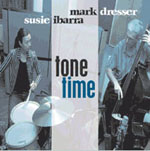|
|
 |
Dusted Reviews
Artist: Susie Ibarra & Mark Dresser Album: Tone Time Label: Wobbly Rail Review date: Feb. 16, 2004 |

|
|
|
 |
In the realm of the more mainstream sectors of avant jazz, Susie Ibarra is a relative newcomer. Her recorded debut, less than 10 years ago, came on the 1995 disc Flowers Grow in My Room, by William Parker’s Little Huey Creative Music Orchestra. It was another year before she began recording in smaller groups, and it wasn’t until 1998 that Ibarra played on a single record whose spine bore her name (Drum Talk with Denis Charles). Still, despite what, in the context of the storied New York scene, could be described as Ibarra’s limited time as a recording artist, she’s managed to play with an impressive list of collaborators, including fellow New Yorker Mark Dresser. Dresser, a staple of New York’s avant jazz family, has been performing since 1972, playing bass with John Zorn, Anthony Braxton, Tim Berne, Gerry Hemingway, and others. Tone Time isn’t the first recorded meeting between Ibarra and Dresser (they collaborated with Eugene Chadbourne and Joe Morris on 2000’s Pain Pen), but it is the first document of the two playing in a duo setting.
As “Protone” begins, Ibarra swiftly and smoothly lays a rhythm beneath Dresser’s playing, the first of many instances in which the level of unspoken communication between Ibarra and Dresser seems so clear and seamless that it’s hard to believe that the two haven’t spent decades on stage together. Both are consistently versatile, especially Dresser, who seems to always find a new way in which to coax sounds from his instrument, but the abundance of variety in the techniques of each player rarely leads to mixed signals or tangents in opposite directions. Ibarra’s rhythms, when utilized, are nearly perfect accompaniment to Dresser’s bass, whether he’s plucking a melodic rhythm of his own or using extended technique to enter more abstract realms.
The recording is equally pleasing when the musicians embrace space and silence instead of dexterity; though it’s easy to long for the buoyant exuberance of the more rhythmic material, the duo’s more reserved side displays an astute sense of composition and communication all its own. In these pieces, Ibarra reaches deep into her cornucopia of small percussion implements, using beads, gongs, and other traditional and non-traditional means. Dresser, throughout, never seems to use the same voice twice, and, like a master linguist, is an expert in any of the languages he chooses to use, whether bowing long, tender phrases, tapping out elastic shuffles on his instrument’s neck, or plucking a catchy, toe-tapping beat.
Given the jazz community’s proclivity to mix and match its players and the duo’s collection of mutual friends, it seems as though it was only a matter of time before Ibarra and Dresser met in a setting such as this. And considering the seamlessness with which they pull off Tone Time, it’s not hard to imagine these two continuing to play together for years to come.
By Adam Strohm
|







